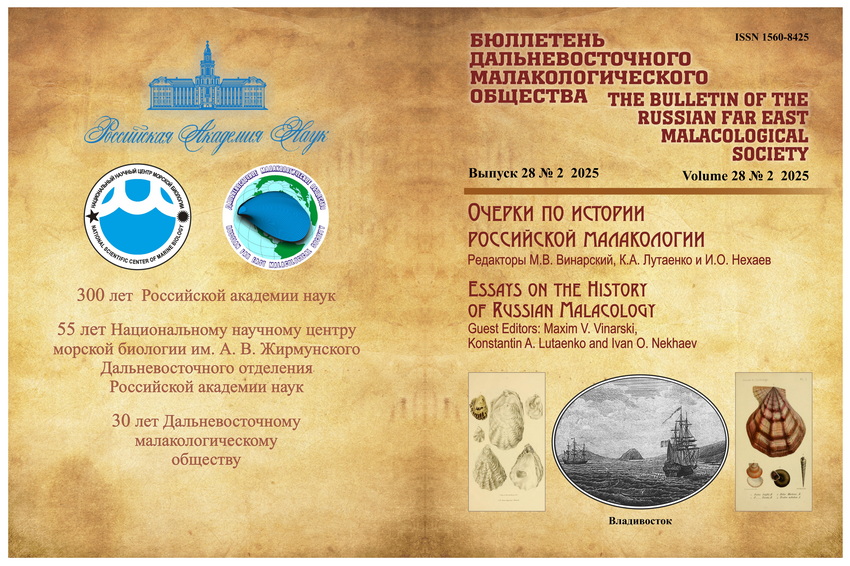The latest issue of the Bulletin of the Russian Far Eastern Malacological Society (2025, vol. 28, No. 2) has been published. It is a special issue entitled Essays on the History of Russian Malacology (Guest Editors: Prof. M.V. Vinarsky (Saint Petersburg State University and the Saint Petersburg Branch of the S.I. Vavilov Institute for the History of Natural Science and Technology, Russian Academy of Sciences), Dr. K.A. Lutaenko (A.V. Zhirmunsky National Scientific Center of Marine Biology, Far Eastern Branch of the Russian Academy of Sciences), and Dr. I.O. Nekhaev (Saint Petersburg State University). This issue is dedicated to the 300th anniversary of the Russian Academy of Sciences, the 55th anniversary of the NSCMB FEB RAS, and the 30th anniversary of the RFEMS. The issue contains seven articles on the history of malacology in Russia, among them are extensive reviews, including those on the state of knowledge of mollusks, and contain a useful and comprehensive bibliography: M.V. Vinarsky, “Three Hundred Years of Malacology in Russia (on the 300th Anniversary of the Russian Academy of Sciences),” I.O. Nekhaev, “Shell-bearing Gastropods of the Eastern Arctic: Historical Aspects and Current State of Knowledge,” and K.A. Lutaenko, “The History of the Study of Bivalves in the Russian Part of the Sea of Japan.” The article by M.V. Vinarsky examines the main stages in the development of malacological research in Russia, from the era of Peter the Great to the present day. It characterizes the activities of leading scientists and scientific schools in the field of malacology, provides quantitative data reflecting the dynamics of the growth of museum collections and the number of actively working malacologists in different historical periods, and discusses the role of the Academy of Sciences and academic institutions in organizing and institutionalizing malacological research in Russia. The review by I.O. Nekhaev (in English) systematizes knowledge about the history and current state of research on shell-bearing gastropods of the eastern Arctic seas, the role of marine biological stations in describing Arctic mollusks, studying their ecology and proposing hypotheses about the factors influencing the distribution of marine fauna. Russian studies, unlike earlier Scandinavian ones, focused on faunistic and ecological aspects, as well as on changes in invertebrate ranges caused by climate, long before this topic became global. In an extensive article by K.A. Lutaenko (170 pages), set against a broad background of natural history research, expeditions and zoological collections in the Russian part of the Sea of Japan, the history of the study of the fauna and taxonomy of bivalve mollusks of the region, starting from the 18th century, is presented and five stages of malacological research are identified, which partially overlap: (1) the first malacological studies (before mid-19th century); (2) second half of the 19th century – early 1920s (the era of Schrenck and the initial accumulation of collections); (3) 1920s – early 1950s (the early Soviet era of expeditions); (4) 1950s – mid-1980s (the "golden years" and the Scarlato era); (5) 1970s – present (the "Far Eastern researcher’s period"). The role of the Institute of Marine Biology/National Scientific Center for Marine Biology in promoting faunistic and taxonomic research on Bivalvia is emphasized, as a result of which it has become a recognized world center for malacology. The studies of Cenozoic mollusks and archaeomalacofaunas of Primorye and Sakhalin are also briefly described, lists of the main expeditions are provided, and biographical data on malacologists and collectors are included. Portraits of collectors, photographs of ships, sampling maps, photographs of mollusks from historical collections, and an extensive bibliography are presented. Other articles in the issue are devoted to the activities of Georgy Filippovich Gerstfeld (1827-1862), a researcher of the Siberian and Russian Far East fauna (T.Ya. Sitnikova, L.A. Prozorova); a review of the fauna of gastropods of the order Cephalaspidea (Gastropoda) of the Far Eastern seas of Russia and adjacent parts of the Pacific Ocean, with a brief outline of the history of the study (E.M. Chaban); the history of the study of the terrestrial malacofauna of Belarus (A.M. Ostrovsky, K.V. Zemoglyadchuk); and the study of the fauna of terrestrial mollusks of the western part of Russia (E.V. Shikov). Additionally, in the sections "Chronicle" and "Losses of Science", articles are published on the occasion of the 30th anniversary of the RFEMS, the 40th anniversary of the Malacological Society of Korea, the anniversary of the renowned zoologist and popularizer of malacology Prof. R.N. Burukovsky, and an obituary of E.N. Egorova, a researcher of Antarctic mollusks.

This is the first special collection of papers on the history of malacology published in Russia, prepared by a team of renowned specialists in various groups of terrestrial, marine and freshwater mollusks. This publication of the RFEMS continues the society's activities in publishing historical materials that previously appeared in its journal. The editorial board and editors of the special issue are grateful to the NSCMB FEB RAS for long-term support of the RFEMS initiatives and its publications.
Announcements and information about the publication are posted on the website of the NSCMB FEB RAS (http://www.imb.dvo.ru/index.php/ru/prochie-novosti-i-ob-yavleniya/2347-pervyj-v-rossii-spetsialnyj-sbornik-opublikovany-ocherki-po-istorii-rossijskoj-malakologii) and the scientific information portal "Poisk" (https://poisknews.ru/anonsy/opublikovany-ocherki-po-istorii-rossijskoj-malakologii/).